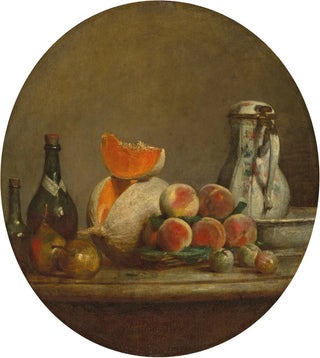Art print | The Melon - Jean Siméon Chardin


View from behind

Frame (optional)
In the vast panorama of art history, some works manage to transcend their era to become symbols of timeless aesthetics. "Le Melon" by Jean Siméon Chardin is one of those creations that captivates and fascinates. This still life, painted in the 18th century, evokes an apparent simplicity but reveals a depth of meaning and a richness of detail that invite prolonged contemplation. Through this piece, Chardin immerses us in a universe where beauty resides in the most ordinary things, transforming a simple melon into a subject of great majesty.
Style and uniqueness of the work
Chardin's style is distinguished by its ability to blend realism and sensitivity. In "Le Melon," each brushstroke seems to pay homage to the texture and color of the fruit. The artist plays with light, creating subtle reflections that bring his subject to life. The composition, both balanced and dynamic, guides the viewer's eye through the nuances of green and orange, while highlighting the roundness and freshness of the melon. This painting is not limited to a simple representation of a fruit; it evokes an atmosphere of calm and serenity, where time appears to stand still. Chardin, through his meticulous approach and mastery of shadows, succeeds in transforming this still life into a true ode to nature, celebrating the beauty of the ephemeral.
The artist and his influence
Jean Siméon Chardin, born in 1699, is often regarded as one of the masters of still life in France. Influenced by the Rococo movement, he developed a unique style characterized by finesse and delicacy. Chardin did not merely reproduce reality; he sought to capture the very essence of his subjects. His work not only marked his era but also inspired many subsequent artists, notably the Impressionists, who saw in him a precursor in the depiction of light and color. The apparent simplicity of his compositions conceals a complexity that continues to question and inspire generations of artists and art lovers. Through his attentive gaze and sense

Matte finish

View from behind

Frame (optional)
In the vast panorama of art history, some works manage to transcend their era to become symbols of timeless aesthetics. "Le Melon" by Jean Siméon Chardin is one of those creations that captivates and fascinates. This still life, painted in the 18th century, evokes an apparent simplicity but reveals a depth of meaning and a richness of detail that invite prolonged contemplation. Through this piece, Chardin immerses us in a universe where beauty resides in the most ordinary things, transforming a simple melon into a subject of great majesty.
Style and uniqueness of the work
Chardin's style is distinguished by its ability to blend realism and sensitivity. In "Le Melon," each brushstroke seems to pay homage to the texture and color of the fruit. The artist plays with light, creating subtle reflections that bring his subject to life. The composition, both balanced and dynamic, guides the viewer's eye through the nuances of green and orange, while highlighting the roundness and freshness of the melon. This painting is not limited to a simple representation of a fruit; it evokes an atmosphere of calm and serenity, where time appears to stand still. Chardin, through his meticulous approach and mastery of shadows, succeeds in transforming this still life into a true ode to nature, celebrating the beauty of the ephemeral.
The artist and his influence
Jean Siméon Chardin, born in 1699, is often regarded as one of the masters of still life in France. Influenced by the Rococo movement, he developed a unique style characterized by finesse and delicacy. Chardin did not merely reproduce reality; he sought to capture the very essence of his subjects. His work not only marked his era but also inspired many subsequent artists, notably the Impressionists, who saw in him a precursor in the depiction of light and color. The apparent simplicity of his compositions conceals a complexity that continues to question and inspire generations of artists and art lovers. Through his attentive gaze and sense






